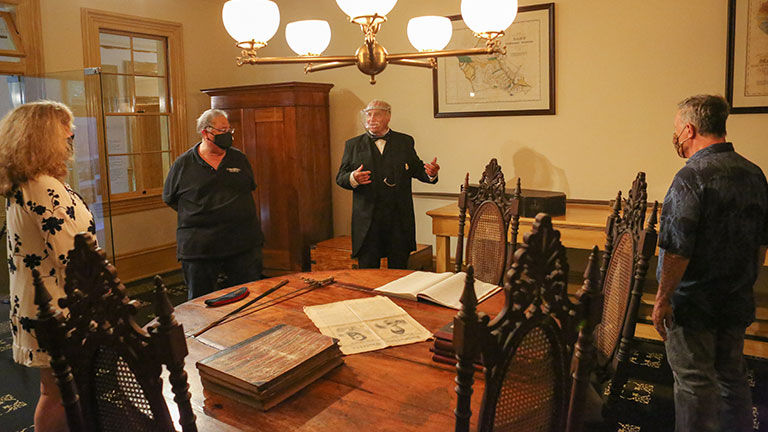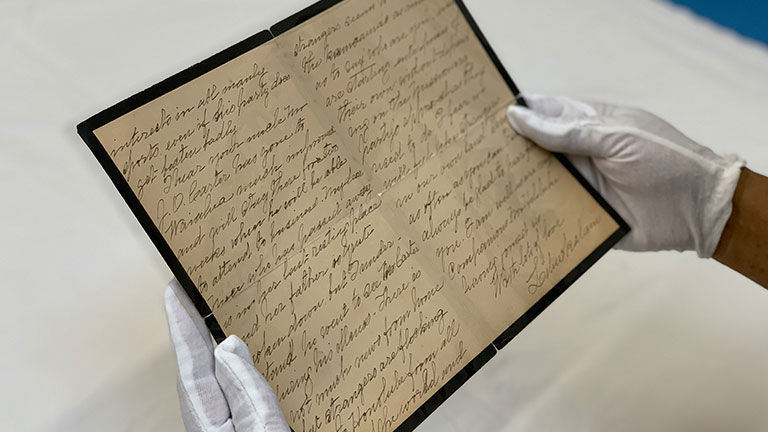I love stories about kings and queens, and Iolani Palace (in downtown Honolulu), the official residence of Hawaii’s last reigning monarchs — King Kalakaua and his sister/successor Queen Liliuokalani — was the setting for many an intriguing tale. The king was actively involved with the construction of the imposing structure, which was completed in 1882. It boasted telephones, electric lights and indoor plumbing — all major innovations at the time.
Discovering Historic Honolulu on a Chamberlain Tour
Dressed in formal Victorian attire right down to a waistcoat and white gloves, Nohea Young was my guide for the Chamberlain’s Tour of the palace. He introduced himself as one of four assistant chamberlains during Kalakaua’s reign, and he played the role of a noble household manager to a tee the entire hour we were together.
Clients will appreciate stepping beyond the ropes and stanchions on this tour to get up-close looks at furniture, art and artifacts and hear little-known stories about the alii’s (royals’) life in the palace.
“When we have balls in the Throne Room, the windows are open and there are floral bouquets everywhere,” Young said. “The Royal Hawaiian Band plays music on the lanai, and His Majesty usually starts off the gala with a waltz. Guests dance from 9 p.m. until midnight, go across the hall for a snack and come back to dance until two or three in the morning.”
The table in the elegant State Dining Room is set for nine with Pillivuyt china from France.
“His Majesty sits at the center of the table, so he can converse with all of his guests,” Young said. “The crystal decanters contain water for the ladies to dilute their wine; after all, it would not be proper for them to get drunk during dinner. The king’s favorite dishes are Western, and we have a French chef on staff. French food is served at all of our state dinners.”
Sixty employees — from guards and gardeners to florists and fishermen — kept palace operations running smoothly. The Chamberlain’s Tour is the only tour that enters the chamberlain’s office, offering an inside look at this undertaking.
 Volunteer docent Hardy Spoehr (in period costume) describes the furniture and artifacts in the chamberlain’s office during the Chamberlain’s Tour.
Volunteer docent Hardy Spoehr (in period costume) describes the furniture and artifacts in the chamberlain’s office during the Chamberlain’s Tour.
Credit: 2022 The Friends of Iolani Palace“My boss, the Lord Chamberlain Curtis Piehu Iaukea, hires the staff, trains them, pays the bills and even oversees packing for the alii’s trips,” Young said. “When Queen Kapiolani and then-Princess Liliuokalani traveled to England in 1887 for Queen Victoria’s Golden Jubilee, they took 84 trunks like these two, made of metal and leather. Each trunk could hold only one outfit.”
I got the impression Young could talk all day and not run out of fascinating anecdotes. The same goes for Zita Cup Choy, the palace’s historian, who leads the first part of another visitor option, the White Glove Tour. Wearing white gloves that they may keep as a memento, clients have the rare opportunity to hold several of the palace’s precious artifacts.
Historic house museums are ultimately about the people. Stories about the alii are richer if we can illustrate them with their personal possessions.
Iolani Palace Treasures
After Kalakaua died in 1891 and Queen Liliuokalani was deposed in 1893, inventories were done. Kapiolani and Liliuokalani sold things and gave things away, and their heirs did the same. The government transferred furniture and other items to the Bishop Museum and other government offices, and auctioned off whatever it could not use.
“About 4,000 of the estimated 10,000 objects that were once in the palace are still missing,” historian Cup Choy said. “The nonprofit Friends of Iolani Palace has spent the past 55 years trying to locate them and bring them back to the palace.”
 One of the items clients might hold during the White Glove Tour is a letter Queen Liliuokalani wrote.
One of the items clients might hold during the White Glove Tour is a letter Queen Liliuokalani wrote.
Credit: 2022 The Friends of Iolani PalaceThe treasures that have been found are maintained with the utmost care. In the attic — headquarters of the Curatorial Services department — I put on my gloves while admiring six pieces that curatorial assistant Chase Benbow had selected to spotlight. The one that immediately caught my eye was the Imperial Order of Saint Alexander Nevsky, which sparkled with 609 diamonds. Named for a 13th-century Russian prince, it was a gift to Kalakaua from Tsar Alexander III in 1894.
“The craftsmanship is incredible,” Benbow said. “Since this was a gift from a foreign head of state — a tremendous honor — it is likely the king wore it on several occasions.”
On May 26, 1899, while she was in Washington, D.C., to lobby for restitution of crown lands that had been ceded to the United States by the Republic of Hawaii, Queen Liliuokalani wrote a letter to a friend, Emily Ladd. In it she made a poignant observation: “Strangers are flocking into Honolulu from all parts of the world. And (they) seem to look at the kamaaina [local residents] as much as to say, ‘Who are you?’ … I fear we will feel like strangers in our own land.”
For its age, the note was in remarkably good condition. And it gave me “chicken skin” to think I was holding something the queen had written with her own hand.
“Historic house museums are ultimately about the people,” Cup Choy said. “Stories about the alii are richer if we can illustrate them with their personal possessions. More objects mean more stories, not just about who owned and used them, but how the items left and came home to Iolani Palace.”
The Details
Iolani Palace